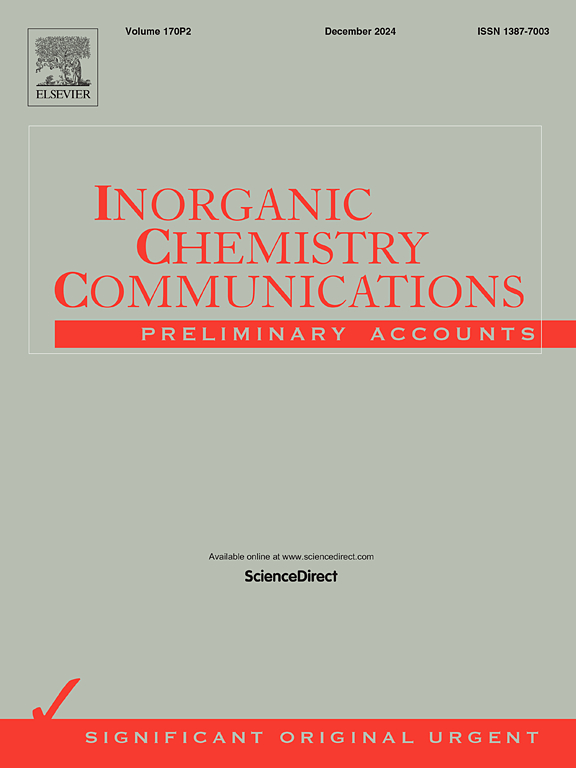生物制备含氟喹诺酮分子的金纳米颗粒,其提取自具有抗菌和抗癌特性的荷氏大肠杆菌土壤分离物的无细胞提取物
IF 4.4
3区 化学
Q1 CHEMISTRY, INORGANIC & NUCLEAR
引用次数: 0
摘要
纳米技术在治疗、药物输送和环境应用方面的潜力引起了生物科学和制药行业的极大兴趣。本研究利用生物分子产生金属纳米颗粒(金)的可能性,即从土壤分离的荷氏大肠杆菌菌株KDY2的无细胞上清液中提取分子。利用FTIR、XRD、SEM和UV-Vis光谱对生物合成的AuNPs进行了分析。XRD和UV-Vis光谱证实了AuNP的产生。SEM图像显示NPs为球形,尺寸小于100 nm, FTIR提供了KDY2 NPs上覆盖分子的细节,如蛋白质,氨基酸和含氟化合物。此外,对生成的NPs进行细胞毒性、抗真菌、抗菌和抗氧化试验。KDY2 NPs抑制革兰氏阳性菌和革兰氏阴性菌的生长。它们对人乳腺癌细胞系MCF-7具有显著的细胞毒性,IC50值为79.50±2.12µg/ml,但对正常细胞系无细胞毒性。MCF-7细胞系也进行了细胞周期分析、线粒体膜电位测试、PS外化、克隆性、台盼蓝染料排除和显微镜检查。western blotting分析显示,kdy2 NP处理的MCF-7细胞中PARP蛋白的裂解表明细胞凋亡的发生。他们都证明KDY2 NPs诱导MCF-7细胞凋亡。对KDY2 NPs进行QTOF-LCMS/MS分析,鉴定其活性代谢产物。这些发现揭示了一种与莫西沙星和诺氟沙星完全相似的分子的存在,指出了NPs抗菌和抗癌特性的潜在机制。KDY2-Au-NPs可以被认为是一种安全有效的抗菌和抗癌纳米颗粒制剂。凭借其卓越的抗癌特性,我们的体外研究首次报道了利用荷氏e.o hormaechei培养上清液制备诺氟沙星覆盖的金纳米颗粒的生物源性。本文章由计算机程序翻译,如有差异,请以英文原文为准。

Biogenically produced Gold nanoparticles containing a Fluoroquinolone molecule from the cell-free extract of E. hormaechei soil isolates with anti-bacterial and anti-cancer properties
Nanotechnology’s potential for therapies, drug delivery, and environmental applications has sparked much interest in the bioscience and pharmaceutical industries. The present study utilizes the possibility of generating metal nanoparticles (gold) using biological molecules, i.e., molecules from the cell-free supernatant of a soil isolate of E. hormaechei strain KDY2. FTIR, XRD, SEM, and UV–Vis spectroscopy were used to analyze the biosynthesized AuNPs. XRD patterns and UV–Vis spectra verified AuNP production. The SEM images showed the spherical shape of the NPs with a size of less than 100 nm, and the FTIR provided details on the capping molecules on the KDY2 NPs such as proteins, amino acids, and a fluoro compound. Additionally, cytotoxic, antifungal, antibacterial, and antioxidant tests were performed on the produced NPs. The KDY2 NPs inhibited the growth of both Gram-positive and Gram-negative bacteria. They showed considerable cytotoxicity in the human breast cancer cell line MCF-7 with an IC50 value of 79.50 ± 2.12 µg/ml, but no cytotoxicity in normal cell lines. The MCF-7 cell line was also subjected to cell cycle analysis, mitochondrial membrane potential tests, PS externalization, clonogenic, trypan blue dye exclusion, and microscopy. The western blotting analysis provided evidence for the cleavage of PARP protein indicating the onset of apoptosis in the KDY 2 NP treated MCF-7 cells. They all demonstrated that KDY2 NPs induced apoptosis in MCF-7 cells. KDY2 NPs were subjected to QTOF-LCMS/MS analysis to identify their active metabolites. The findings revealed the presence of a molecule that is exactly like Moxifloxacin and norfloxacin, pointing to the mechanism underlying the antibacterial and anti-cancer properties of the NPs. KDY2-Au-NPs may be considered a secure and potent nanoparticle formulation for antimicrobial and anti-cancer uses. With its exceptional anti-cancer characteristics, our in vitro study is the first to report on the biogenic creation of Gold nanoparticles capped with Norfloxacin utilizing E. hormaechei culture supernatant.
求助全文
通过发布文献求助,成功后即可免费获取论文全文。
去求助
来源期刊

Inorganic Chemistry Communications
化学-无机化学与核化学
CiteScore
5.50
自引率
7.90%
发文量
1013
审稿时长
53 days
期刊介绍:
Launched in January 1998, Inorganic Chemistry Communications is an international journal dedicated to the rapid publication of short communications in the major areas of inorganic, organometallic and supramolecular chemistry. Topics include synthetic and reaction chemistry, kinetics and mechanisms of reactions, bioinorganic chemistry, photochemistry and the use of metal and organometallic compounds in stoichiometric and catalytic synthesis or organic compounds.
 求助内容:
求助内容: 应助结果提醒方式:
应助结果提醒方式:


